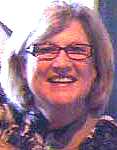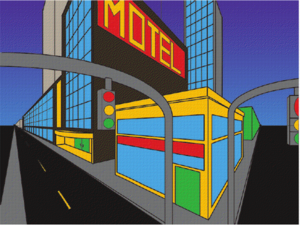After learning about Studio-Based Learning (SBL) from Pat Donohue, I interviewed her to learn about the benefits of this approach and why and how SBL personalizes learning. Pat is inspired by a passion to create engaging environments for learning.
“There is a fundamental problem with public school as it has come to be defined. Confining young adults away from the world has created environments loaded with discipline problems and excruciating boredom. The challenge of the classroom teacher to engage young minds in the real subject matters of life while students are stuck in their chairs was clearly a losing task (see Gatto, 1992).
If you watch children or young adults in the natural world, it will not take long to notice two things: they will soon be engaged in some kind of learning borne out of their own curiosity and/or they will be engaged in making fun – usually both. To this day I cannot fathom why education cannot be a replication of this natural tendency of human beings to learn about the life they lead.”
What is Studio-Based Learning?
Studio-based learning in America can be traced back to John Dewey’s Laboratory School in Chicago in the late 1800’s (Lackney, 1999). It was later adopted by North American architectural education and showed up in the University of Oregon Architectural School in 1914. Lackney describes the design studio as, “A type of professional education, traditional in schools of architecture, in which students undertake a design project under the supervision of a master designer. Its setting is the loft-like studio space in which anywhere from twelve to as many as twenty students arrange their own drawing tables, papers, books, pictures, drawings and models. In this space, students spend much of their working lives, at times talking together, but mostly engaged in private, parallel pursuits of the common design task (quoting Schon, 1983).”
Primary concepts that drive studio-based learning include:
- Students work like apprentices in a common space under the tutelage of a “master.”
- Students interact when needed with each other on their designs.
- Students undergo periodic critiques, known as “crits,” of their designs, projects, or products. Crits are for gaining knowledge about your work. They occur student-to-master first and then evolve self-learning crits between peers.
- It is driven by the pragmatic. The idea is to get your hands in your work, get it done, revise it to perfect it, and self-evaluate the results.
- Final work or products are presented publicly.
Studio-based learning methods were picked up in various iterations in K-12 programs and in universities throughout the 20th Century. The use of SBL educational laboratories died down in 1970s and 1980s but never died-out. Today, SBL is experiencing a revival. The originators of the SBL model we pursue run the Intelligent and Interactive Systems Lab at Auburn University and partners at Washington State University have launched the Online Studio-Based Learning Environment (OSBLE) where instructors from around the country can share their experiences and growing knowledge about the model’s effectiveness.
In 2006, John Seely Brown published a short but hard-hitting article, “Exploring the edge: New Learning Environments for the 21st Century” on the architectural studio model as a foundation for current trends in learning. He explains:
In the architecture studio, for example, all work in progress is made public. As a consequence, every student can see what every other student is doing; every student witnesses the strategies that others use to develop their designs. And there is public critique, typically by the master and perhaps several outside practitioners.
The students not only hear each other’s critiques, but because they were in some sense peripheral participants in the evolution of each other’s work, they also have a moderately nuanced understanding of the design choices and constraints that led to the final result … If you look at the learning outcomes for the architecture studio and Professor Belcher’s physics classes, it is evident that in both environments, students move from ‘learning about’ something to ‘learning to be’ something—a crucial distinction.
I believe studio learning is a preferred environment for our educational system, ideas about: situated learning, collaborative learning, personal learning networks and personal learning environments, mobile computing and its ability to deliver an SBL environment into a learner’s hands, and authentic instruction.
How did you build this passion for experiential learning approaches?
Fifteen years ago, I set out with a Master’s degree in Instructional Technologies to a new professional life, inspired by a passion to create engaging environments for learning. I had been a high school science and English teacher in a central urban school district (Oakland, CA) and a highly rural school district (Lake County, CA). I set out in 1997 on a path that led me to one year of science and mathematics software production for an educational technology publisher, followed by eight years in STEM education grants – six years as Principle Investigator for a U.S. Department of Education grant serving schools in rural North Dakota and two years as Project Director on a similar National Science Foundation (NSF) grant for rural schools in the six Hawaiian Islands. The North Dakota grant was housed in a Science Center and that experience cemented my love of informal education approaches to learning.
In Hawaii, I left the grant position on the advice of my university colleagues to enter into their Ph.D. program in Communication and Information Sciences. That program introduced me to new research colleagues whom I work with today. Our research focused on instructional models that integrated technology to raise the learning bar in science, mathematics, and computer science. I eventually came to see the most important part of STEM learning is the “E.” Engineering is, more often than not, where the other three fields come together in hands-on applications. We began to look at instructional models that would situate student learning in practice. My colleagues joined with two other universities in a grant to develop and test a model of Studio-Based Learning (SBL). They are now in their second implementation grant of the SBL program through NSF. Multiple universities and instructors around the country have been involved in one or both of the SBL grant work and the results are showing that, in college undergraduate computer science courses,
SBL shows improvement gains for students compared to those in non-SBL courses. I extended the SBL protocol to a pilot program for high school and am now investigating a revision of the model into a “Design Studio” approach that integrates SBL methods into a more robust laboratory of learning experiences.
What are the findings from neuroscience?
Findings from neuroscience has expanded the picture of what is happening in the studio when learning is occurring. Something I now tell my students that makes them sit up with new attention is,
“every moment we talk here; every day you leave this classroom, you have a new brain.”
The point is, from neuroscience research (c.f., John Medina’s Brain Rules at www.brainrules.net), we know that the neurons in our brain form networks of connections that are in some mysterious way we still don’t understand how we store our learning. That learning is individual and based on the numerous factors that shape our individual connections. We learn constantly. In fact, tell yourself to “stop learning.” It can’t be done. This means that every moment of our lives we are re-forming our connections with every new or evolving thought. New thought; new connections; new brain. I find that brain boggling! And, of course, I want to know more.
Currently, we are designing an evolution of our Instructional Technology department to embrace a studio environment using SBL principles. I am working with colleagues in the Education departments to reformulate our SBL model into a more rigorous approach for all grade levels and all disciplines to personalize learning in educational contexts. That will involve development of mobile learning approaches to the studio experience and it will involve creating physical laboratory spaces on campus where we implement and research this evolving method of instruction.
 Patricia (Pat) Donohue, Ph.D.
Patricia (Pat) Donohue, Ph.D.
Assistant Professor, Department of Instructional Technologies
Graduate College of Education, San Francisco State University
President and CEO, Community Learning Research LLC
Pat Donohue teaches instructional design and technologies in the Department of Instructional Technologies at San Francisco State University’s Graduate College of Education. She is also President and CEO of Community Learning Research, LLC, a private educational research company located in the Napa Valley, California. She holds a doctorate degree in Communication and Information Sciences from the University of Hawai`i at Manoa and her Master’s in Education: Instructional Technologies degree from San Francisco State University where she currently teaches courses in Foundations of Instructional Design Theory, Learning with Emerging Technologies, and Usability Testing and Formative Evaluation.
Pat worked as a professional development specialist in new technologies and learning for 20 years prior to her current position, eight of which were on federal teacher development grants in STEM (science, technology, engineering, and mathematics) education. Pat was Principal Investigator for NatureShift, a U.S. Department of Education Technology Innovation Challenge Grant (6.5 yrs.) and interim Project Director for Hawai`i Networked Learning Communities, a National Science Foundation Rural Systemic Initiative grant for the Hawai`i Department of Education (1.5 yrs.). Both grants involved technology integration in cultural contexts into curriculum and instruction and teacher professional development in STEM, history, and language literacy for rurally isolated schools in the Northern plains states and the six Hawaiian Islands. Pat taught high school science and English for six years and has taught several university education courses prior to her current position. She held administrative positions at the University of Hawai`i and at San Francisco State and Sonoma State Universities. For a brief period, she published the Middletown Times Star, a small newspaper in Northern California.
With a lifelong interest in the learning sciences, Pat’s research has covered technology innovations for learning, cultural implications and impacts on learning, and advanced technology environments for collaborative learning. She is currently researching a new pedagogical model based on traditions of Studio-Based Learning and investigating the implementation of that model into mobile learning environments.
Community Learning Research LLC
http://communitylearningresearch.com
Patricia Donohue, PhD, CEO
pjdonohue@gmail.com
011.925.451.7820 (M/SMS)
References
- Gatto, J. T. (1992) Dumbing Us Down.
- Lackney, J. A. (1999) A History of the Studio-Based Learning Model.
- Report of a Workshop on The Scope and Nature of Computational Thinking, Committee for the Workshops on Computational Thinking; National Research Council (2010).
- Mitchell Resnick (2002) Rethinking Learning in the Digital Age. Chapter 3: pp32-37.
- Mitchell Resnick (2007) Sowing seeds for a more creative society. ISTE
- Stephen Cooper, Lance C. Pérez, and Daphne Rainey (2010) K–12 Computational Learning: Enhancing student learning and understanding by combining theories of learning with the computer’s unique attributes. Education, v.53(11) pp 27-29.
- Hundhausen, C., Narayanan, N., and Crosby, M. (2008) Exploring Studio-Based Instructional Models for Computing Education




[…] https://barbarabray.net/2012/06/09/studio-based-learning-interview-pat-donohue/ […]